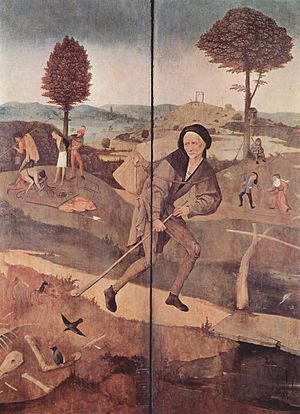
Mateo Gomez/Mateo Viñes 1997
“El peregrino de la vida humana del Bosco” (Isabel Mateo Gomez and Julián Mateo Viñes) 1997
[in: Archivo Español de Arte, vol. 70 (1997), pp. 297-302]
Many scholars think that the wayfarer figure in the exterior panels of Bosch’s Haywain triptych is based on a contemporary literary source. Mateo Gomez and Mateo Viñes believe that they have found this source, namely El Peregrino de la Vida Humana, a text written by brother Vicente Mazuelo and published in Tolosa in 1490. This is the Spanish translation of Guillaume de Deguilleville’s Pèlerinage de la Vie Humaine (14th century). In a number of woodcuts from this edition the pilgrim of life is holding a stick (according to the text intended to ‘protect from dangers’), and Bosch’s figure is also holding a stick. The text ends with the statement that the tribulations of the pilgrim of life are meant as a warning for those who still have to engage upon their pilgrimage of life. ‘Undoubtedly’ Bosch’s figure conveys the same message, although with Bosch the final destiny of the pilgrimage of life seems to be less hopeful than in the allegorical text of Mazuelo/Deguilleville.
[explicit 5th July 2019]